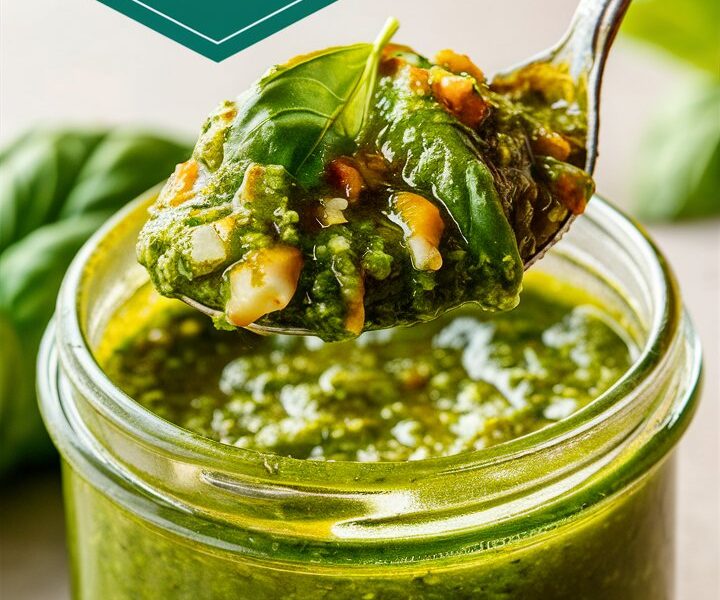Few sauces capture freshness and simplicity as beautifully as homemade basil pesto. With its vibrant green color, fragrant aroma, and bold flavor, pesto is a timeless Italian classic. Unlike store-bought jars, which can taste dull or overly oily, homemade pesto bursts with life. Each spoonful carries the peppery sweetness of basil, the nutty depth of Parmesan, the richness of olive oil, and the sharp kick of garlic.
What makes it truly special is its versatility. Pesto is not just for pasta—it’s a kitchen staple that enhances everything from grilled meats to breakfast toast. Making it at home also allows you to control the quality of ingredients, adjust flavors to your taste, and create a sauce that feels authentic and personal.
In today’s fast-paced world, it’s refreshing to know that one of the most flavorful sauces requires less than ten minutes to prepare. Whether you’re a beginner or a seasoned cook, homemade basil pesto is your shortcut to gourmet flavor at home.
2. A Brief History of Basil Pesto
The origins of pesto date back hundreds of years to Genoa, a coastal city in the Liguria region of northern Italy. The word pesto comes from the Italian verb pestare, meaning “to pound” or “to crush,” referring to the traditional method of making it with a mortar and pestle.
The earliest versions of pesto were not identical to the basil-based version we know today. Ancient Romans prepared a paste called moretum, made with garlic, herbs, cheese, and olive oil. Over time, Ligurian cooks perfected the recipe using the fragrant basil that thrived in their Mediterranean climate. By the 19th century, basil pesto had become firmly associated with Italian cuisine, particularly with Genoa.
Today, pesto has traveled far beyond Italy. It appears in kitchens worldwide, with countless variations that reflect local tastes and ingredients. Yet, the classic Genoese version—made with basil, pine nuts, Parmesan, garlic, olive oil, and salt—remains the most beloved. When you make pesto at home, you’re not just preparing a sauce; you’re carrying on a culinary tradition that has delighted generations.
3. Essential Ingredients for Perfect Pesto
The magic of pesto lies in its few but powerful ingredients. Each component plays a vital role in achieving balance and depth of flavor.
- Fresh Basil: Use large-leaf sweet basil for the most authentic flavor. The leaves should be bright green and aromatic.
- Parmesan Cheese: Adds a salty, nutty richness that grounds the sauce. Grating it fresh enhances flavor.
- Olive Oil: Extra virgin olive oil provides smoothness and fruity undertones. Choose a mild variety so it doesn’t overpower the basil.
- Pine Nuts: Traditional and buttery, they add texture and a delicate nuttiness. For alternatives, walnuts, cashews, or almonds also work beautifully.
- Garlic: Just a clove or two is enough to deliver sharp, pungent contrast.
- Lemon Juice: A splash of acidity brightens the sauce and helps preserve its green color.
- Salt and Black Pepper: Essential for seasoning and balance.
When combined, these ingredients form a harmony of flavors—herbaceous, savory, nutty, and zesty—that makes pesto irresistible.
4. Step-by-Step Guide to Making Basil Pesto at Home
Making homemade basil pesto is refreshingly easy. Follow these steps for a perfect result every time:
Step 1: Prepare the Basil
Wash fresh basil leaves gently and dry thoroughly. Moisture can dull both the flavor and color of your pesto. A salad spinner works best, but patting with paper towels also helps.
Step 2: Toast the Nuts
Place pine nuts in a dry skillet over medium heat for a few minutes until golden and fragrant. This step deepens their flavor and adds warmth.
Step 3: Blend the Ingredients
In a food processor, combine basil, Parmesan, garlic, lemon juice, toasted nuts, salt, and pepper. Pulse until the mixture resembles a thick paste.
Step 4: Add Olive Oil
With the processor running, slowly stream in olive oil until the sauce reaches a smooth, creamy consistency. Scrape down the sides as needed.
Step 5: Adjust the Flavor
Taste and adjust seasoning. Add more salt for depth, lemon juice for brightness, or cheese for richness.
Step 6: Use or Store
Use immediately with your favorite dishes or store in a sealed container. For longer storage, freeze in small portions.
This process takes less than 10 minutes but yields a sauce that can transform countless meals.
5. Pro Tips for Achieving Vibrant Color and Flavor
- Keep Basil Dry: Water causes pesto to oxidize and turn brown.
- Chill the Blade: Cooling your food processor blade before use helps keep the sauce bright green.
- Balance the Lemon: Add lemon juice gradually—too much can overwhelm the basil.
- Don’t Overblend: Overprocessing can warm the sauce, leading to dull flavor. Short pulses are better.
- Add Oil Last: Incorporating olive oil slowly ensures a silky texture.
- Double the Batch: Pesto freezes wonderfully. Making more at once saves time later.
These simple practices elevate your pesto from good to extraordinary.
6. Delicious Ways to Use Basil Pesto
Homemade basil pesto is more than just a pasta sauce. Here are creative ways to enjoy it:
- Tossed with spaghetti, penne, or linguine.
- Spread inside a grilled cheese or panini.
- Drizzled over roasted vegetables.
- Mixed into grain bowls with quinoa or rice.
- Used as a pizza base instead of tomato sauce.
- Swirled into soups for depth.
- As a dip for breadsticks or crackers.
- Mixed into scrambled eggs for a herby breakfast.
- As a marinade for chicken, shrimp, or steak.
The possibilities are endless, making pesto one of the most versatile sauces in your kitchen.
7. Variations and Substitutions You’ll Love
Part of the fun of pesto is adapting it to your taste. Here are some variations:
- Nut-Free Pesto: Replace nuts with sunflower or pumpkin seeds.
- Dairy-Free Pesto: Use nutritional yeast or vegan Parmesan.
- Spinach or Kale Pesto: Add leafy greens to stretch basil and boost nutrients.
- Cilantro or Parsley Pesto: Experiment with other herbs for unique flavors.
- Spicy Pesto: Add a pinch of red pepper flakes for heat.
- Roasted Garlic Pesto: Roast the garlic beforehand for a sweeter, milder profile.
These variations let you reinvent pesto each time you make it.
8. Storage and Freezing: Keeping Pesto Fresh Longer
Pesto is best enjoyed fresh, but with proper storage, it can last for weeks or even months.
- Refrigeration: Store in an airtight container for up to 5 days. Cover the surface with a thin layer of olive oil to prevent browning.
- Freezing: Freeze in ice cube trays, then transfer to freezer bags. This way, you can use single portions whenever needed. Pesto keeps its flavor for up to 3 months when frozen.
- Important Tip: Avoid heating pesto directly on the stove. Instead, stir it into hot dishes after cooking to preserve flavor and color.
With these storage methods, your homemade pesto will always be ready when you need it.
9. Frequently Asked Questions About Homemade Basil Pesto
Can I freeze basil pesto?
Yes! Freezing in small portions ensures you can use it conveniently later.
Can I make it without a food processor?
Absolutely. A mortar and pestle is the traditional method, and it creates a rustic texture with deeper flavor. A blender also works.
What’s the best olive oil to use?
Choose a mild extra virgin olive oil. Stronger varieties may overpower the basil.
Can I make pesto vegan?
Yes—simply substitute Parmesan with nutritional yeast or a plant-based cheese alternative.
How much pesto should I use per serving of pasta?
A good rule is ⅓ to ½ cup of pesto per 8 ounces of cooked pasta.
Why does pesto sometimes turn brown?
Oxidation occurs when basil is exposed to air. Lemon juice and olive oil help slow this process.
10. Final Thoughts: Why Basil Pesto Belongs in Every Kitchen
Homemade basil pesto is proof that great food doesn’t need to be complicated. With a handful of ingredients, you can create a sauce that is fresh, flavorful, and endlessly versatile. From pasta to proteins, from breakfast to dinner, pesto can elevate your cooking in countless ways.
Making it at home means you’re not only enjoying superior taste but also connecting with a culinary tradition that spans centuries. It’s a small act of creativity that delivers big rewards.
So next time you have fresh basil on hand, don’t let it go to waste—transform it into a batch of pesto. Store it, share it, and most importantly, enjoy it. This green gem of Italian cuisine deserves a permanent spot in your kitchen repertoire.





